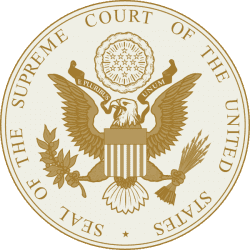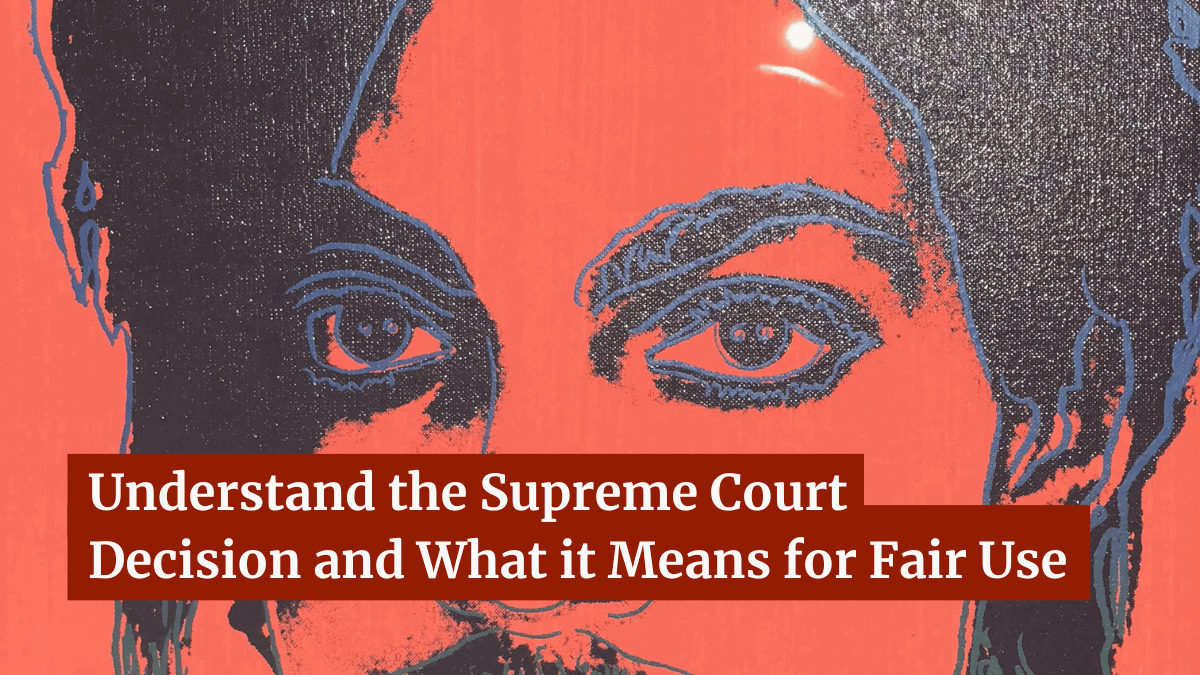How the Warhol Ruling Could Change Fair Use

Earlier today, the Supreme Court of the United States (SCOTUS) handed down their long-awaited ruling in the dispute between the Andy Warhol Foundation (AWF) and photographer Lynn Goldsmith (full decision linked in footer).
The ruling found that Warhol violated Goldsmith’s copyright when creating a series of paintings based on her photograph of the musician Prince.
The AWF, however, argued that the paintings were a fair use, specifically that they were transformative works that are allowed under the law.
The district court sided with the AWF, though the Second Circuit Court of Appeals overturned that decision. That sent the case to the Supreme Court, which released their ruling today.
In a 7-2 decision, the court found in favor of Goldsmith, ruling that the images were infringing and that Warhol’s works were not a fair use of Goldsmith’s photograph.
The case is the second major fair use ruling in the past three years, following the Google v Oracle ruling in April 2021. However, given how narrow that case was, applying solely to software code, the Warhol case is the first broad SCOTUS decision on fair use in nearly 30 years.
As such, it’s important to both understand this ruling and look at the ways it will likely change copyright, in particular fair use, moving forward.
Background of the Case
The history of the case goes all the way back to 1981. That was when Goldsmith, on assignment for Newsweek, snapped the iconic photo of the then-up-and-coming musician Prince (along with 22 other photos).
Three years later, in 1984, she licensed the image to Vanity Fair magazine, who contracted with Andy Warhol to create the equally iconic painting of Prince for their cover.
However, after the death of Prince in April 2016, it came to light that the AWF had a group of 15 images based on the photo. Vanity Fair licensed the Warhol images but, according to Goldsmith, those additional images were created outside the contract that she signed.
In April 2017, the AWF sued Goldsmith. Goldsmith had been raising the concerns and the AWF proactively sued seeking a declaratory judgment of non-infringement. Goldsmith filed a counterclaim, alleging that the AWF had committed copyright infringement.
The district court found in favor of the AWF, ruling that the images were transformative and that Warhol’s works were a fair use. However, that decision was quickly overturned by the Second Circuit Court of Appeals, which found that the paintings were not a fair use.
That sent the dispute up to the Supreme Court, which agreed to hear the case. Oral arguments in the case were heard in October 2022, with the final decision coming out today.
That decision is a 7-2 one that sides with Goldsmith, finding that the district court erred in its analysis and that Warhol’s work was not a protected fair use. This, in turn, kicks the case back to the lower court for a potential trial on other elements as well as damages.
But no matter how the case pans out moving forward, this Supreme Court decision is important, and it’s going to have major impacts on creators of all types, especially those who use others’ work in their creations.
A Major Shift in Fair Use
To understand why this decision in important, one has to first understand both what fair use is and how it has been recently interpreted.
Fair use is an exemption under copyright law that allows unlicensed use of copyright-protected works for certain purposes. Some commonly given examples include using clips from a film when reviewing it, creating a parody of a work, or using small snippets as part of news reporting.
However, determining what is and is not a fair use is often difficult. Under the law, there are four factors that judges and/or jurors are required to consider.
- The purpose and character of the use, including whether such use is of a commercial nature or is for nonprofit educational purposes;
- The nature of the copyrighted work;
- The amount and substantiality of the portion used in relation to the copyrighted work as a whole; and
- The effect of the use upon the potential market for or value of the copyrighted work.
However, the discussion over fair use has largely been about the first and fourth factors, which are given the most weight. That’s especially true with the first factor, which has been the dominant one since 1994.
That was when the Supreme Court handed down its ruling in the Campbell v. Acruff-Rose Music case. That lawsuit was over the 2 Live Crew song Pretty Woman, which was a parody of the 1964 Roy Orbison song Oh, Pretty Woman.
The Pretty Woman case was where SCOTUS codified the idea of transformativeness in fair use law. Previously, courts had looked more at the commercial nature of the work, but, in finding in favor of 2 Live Crew, the court put the focus on how transformative the new work is, meaning it gave the work a new meaning or purpose, and largely ignored the fact that it was a commercialized work.
Though the Supreme Court may or may not have intended it, that ruling has been the guidance on fair use issues for nearly three decades. Some fair use decisions have even stopped at the question of transformativeness, such as the case of a photographer who (initially) had her case tossed on fair use grounds, even though it was simply cropped and placed on a business website.
It’s also been a big part in cases involving artists such as Jeffrey Koons and, more recently, Richard Prince.
But the glory days of the transformative use test are likely behind us. The Supreme Court has made one thing very clear, there’s much more to fair use than being transformative.
Transformative Use: 1994-2023?
To be clear, nothing in this ruling says that transformative use is exiting the conversation. However, the ruling is definitely an attempt by the Supreme Court to reign in the interpretations of fair use that have emerged since Campbell v. Acruff-Rose Music.
What the ruling basically says is that a transformative use is not, by itself, an indication that a work is a fair use. The court makes it clear that, not only does transformative use not dominate all four factors, it doesn’t solely dominate even the first.
According to the decision, when, “Commentary has no critical bearing on the substance or style of the original composition, . . . The claim to fairness in borrowing from another’s work diminishes accordingly (if it does not vanish), and other factors, like the extent of its commerciality, loom larger.”
In short, since the Warhol works were not offering any commentary on Goldsmith’s photograph or Prince as an artist, the commercial nature of Warhol’s work had to be given much more weight. When viewed that way, the court found that Warhol’s work was not a fair use.
While that may sound logical, especially when one looks at what the first factor says, it’s not how many courts interpreted the Pretty Woman decision. In many cases, the courts found that the transformative use of a work was the dominant, if not the sole, factor they weighed in determining fair use.
Now SCOTUS has reframed the issue as being just an element of the first factor, not necessarily the dominant one within that factor, much less the dominant factor overall.
The reason for that, according to the court, is that leaning too heavy on the question of transformative use risks eliminating the right a creator has to prepare derivative works based on their creations.
The court specifically cites the example of turning a book into a movie, noting that an overly broad interpretation of transformative use could make it impractical for a rightsholder to prevent an unauthorized adaptation.
In short, expect the dialogue around fair use to change in the coming months and years. Though courts, in recent years, have taken a more bright line approach to looking at transformative use in fair use cases, this deliberately muddies the water and makes it so that future fair use analyses have to weigh a larger number of factors.
However, that is not necessarily a bad thing. Fair use is meant to be a bit muddy. It’s part of how fair use remains flexible. Any single element becoming too powerful, like transformative use had in recent decades, sets the stage for would-be infringers to game the letter of the law as a means to violate the intent.
Bottom Line
To be clear, the ruling just came out a few hours ago. I’m sure that there is much more that I’ll be saying about it in the coming weeks and months. This will not be the final word about this ruling.
However, we won’t know the outcome of this decision for years or even decades. Just like we didn’t fully understand the tidal shifts caused by Campbell v. Acruff-Rose Music until surprisingly recently, this one will take it’s time filtering through the courts.
That said, this is likely a major win for photographers, musicians and any creative person who routinely has their work used by others in the creation of new works. Appropriation artists, musicians who sample, and others that are frequent users of outside material need to be more cautious.
In the end, we rarely get fair use decisions from the Supreme Court and, often times, when we do, they are severely limited, such as the Google v. Oracle decision.
This will be a case we discuss, analyze and cite for a long, long time to come. Today is a major day in U.S. copyright history. The only question is what the exact impacts will be long term.
Want to Reuse or Republish this Content?
If you want to feature this article in your site, classroom or elsewhere, just let us know! We usually grant permission within 24 hours.
